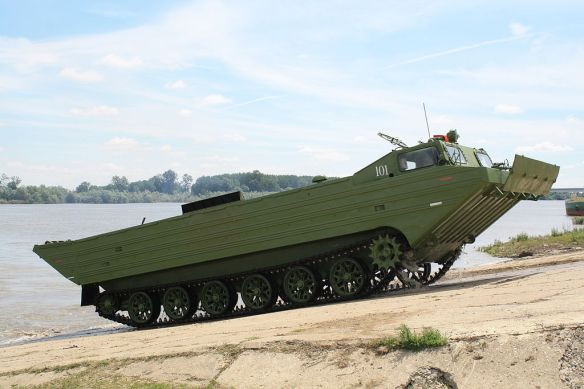Soviet-made tracked amphibious transport PTS-M of Serbian River Flotilla 1st Pontoon Battalion.
PTS amphibious vehicle
The PTS has been in Egyptian service for some years, its amphibious carrying capacity having been used to good effect during the Yom Kippur war of 1973.
The PTS amphibian entered service with the Soviet army in the mid-1960s, and in comparison with the earlier K- 61 amphibian has a greatly increased load-carrying capability, slightly higher speed on both land and water, and can also tow a trailer when afloat. The PTS has a steel hull with the crew compartment at the very front of the hull and the cargo area stretching back right to the rear. The crew compartment, unlike those on the earlier K-61 and BAV-485, is fully enclosed, the two-man crew entering via two circular roof hatches An NBC system is provided to enable the vehicle to operate in an NBC-contaminated area, The engine is beneath the vehicle, with the exhaust pipes on top of the cargo compartment on each side, a configuration which in certain conditions could permit exhaust fumes to be blown back into the cargo area, an unfortunate situation when troops are being carried. The PTS can carry a maximum of 5000kg (11,023lb) of cargo on land and 10000kg (22,0461b) on water, or up to 70 or so fully equipped troops. Cargo and vehicles such as a Ural- 375D 6×6 4000-ks (B, B1B-lb) truck can be loaded into the PTS via the rear tailgate, which has two integral loading ramps. The suspension of the vehicle is of the torsion-bar type with six dual rubber tyred road wheels, plus a drive sprocket at the front and an idler at the rear; there are no track-return rollers. The vehicle is driven in the water by two propellers mounted in tunnels under the rear of the hull, and steered by two rudders, Before the vehicle enters the water a trim vane is erected at the front to stop water swamping the forward part of the vehicle, and the bilge pumps are switched on. AII vehicles have a front-mounted winch (to recover other vehicles and equipment, or to assist in self-recovery), night driving equipment, a searchlight mounted on top of the crew compartment, radios and an intercom.
The PTS can also tow the specially developed PKP boat shaped two- wheel trailer, which is provided with ramps to enable cargo to be loaded, This has two sponsons, one on each side: for land travel these are folded on top of the trailer but before entering the water they are swung through 180* and locked in positron to provide additional buoyancy, The trailer is used to carry a 122-mm (4 8-in) D-30 howitzer while the PTS vehicle carries the truck, ammunition and crew. The latest production version is the PTS-M, which has minor differences including increased fuel capacity.
The PTS-M is found in the surveillance equipment, radio communication, an intercom system, and high of motorized rifle and tank divisions. It is capacity bilge pump. The cabin fully enclosed also found in engineer amphibious units at and the PTS-M is capable of operating in an Army and Front level, nuclear and chemical environment and in amphibious company of engineer battalions.
In assault operations, it is used to ferry troops and cargo. In bridging operations, it is used as a floating crane, an expedient for a shore deadman, and cable anchorage transporter. In ice-crossing operations, it is fitted with special attachments and used to clear lanes from broken ice. And finally, in bridge destruction operations, it is used to ferry demolition crews and equipment water-15 km/h (9.3 mph).
The only known variant is one used by Poland, which has a rocket-propelled mine-clearing system mounted in the rear. In addition to being used by most members of the Warsaw Pact, the PTS is also operated by Egypt, Iraq and Syria.
SPECIFICATIONS
Year into service: 1965
Manufacturer: Kurganmashzavod
Crew: 2
Engine Type: V46-5 Quad Valve
Eng Layout: V 12
Eng Starting Primary: Air
Engine Displacement: 38,880 cc
Engine BHP: 710 BHP
Engine Torque: 880 ft lbs
Engine Bore x Stroke: 150 mm x 150 mm
Dimensions Length: 11,500 mm
Dimensions Width: 3,300 mm
Dimensions Height: 2,650 mm
Cargo area length: 8,000 mm
Carge area width: 2,900 mm
Cargo area height: Enc 1,700 mm Exc 4,000 mm
Fuel consumption: N/A
Fuel Multi: Yes
Fuel Quantity: 860 Ltr
Fuel range: 300 km
Trench clearance: 2,500 mm
Max Road Speed: 60 kph
Max Off-Road Speed: 45 kph
Amphibious: Yes
Amphibious type: Screw Jet
Amphibious speed: 12 kph
Amphibious time: 18 Hours
Amphibious bearing: 12,000 kg
Max ascent angle: 60 Degrees
Max descent angle: 52 Degrees
Side slope: 35 Degrees
Vertical obstacle: 650 mm
Ground clearance: 400 mm
Ground pressure: 0.56 kg / cm2
Weight Combat: 34,000 kg
Weight Empty: 24,000 kg
PTS-4
The PTS-4 has a total weight of 33 tons with a payload of 12 tons on land and 18 tons on water. The vehicle is able to reach a maximum speed on road of 60 km/h and 15 km/h on water.
Developed since 2007 by the Russian Defense Company Uralvagonzavod, the PTS-4 is based on the suspension of main battle tank T-80 and gears of main battle tank T-72. The PTS-4 can carry infantry fighting vehicles, armoured personnel carrier and trucks.
The PTS-4 will be ready to enter in production. In 2011, the vehicle has passed a series of qualification tests. The PTS-4 has a fully-enclosed armored cab. It provides protection against small arms fire and artillery shell splinters.
